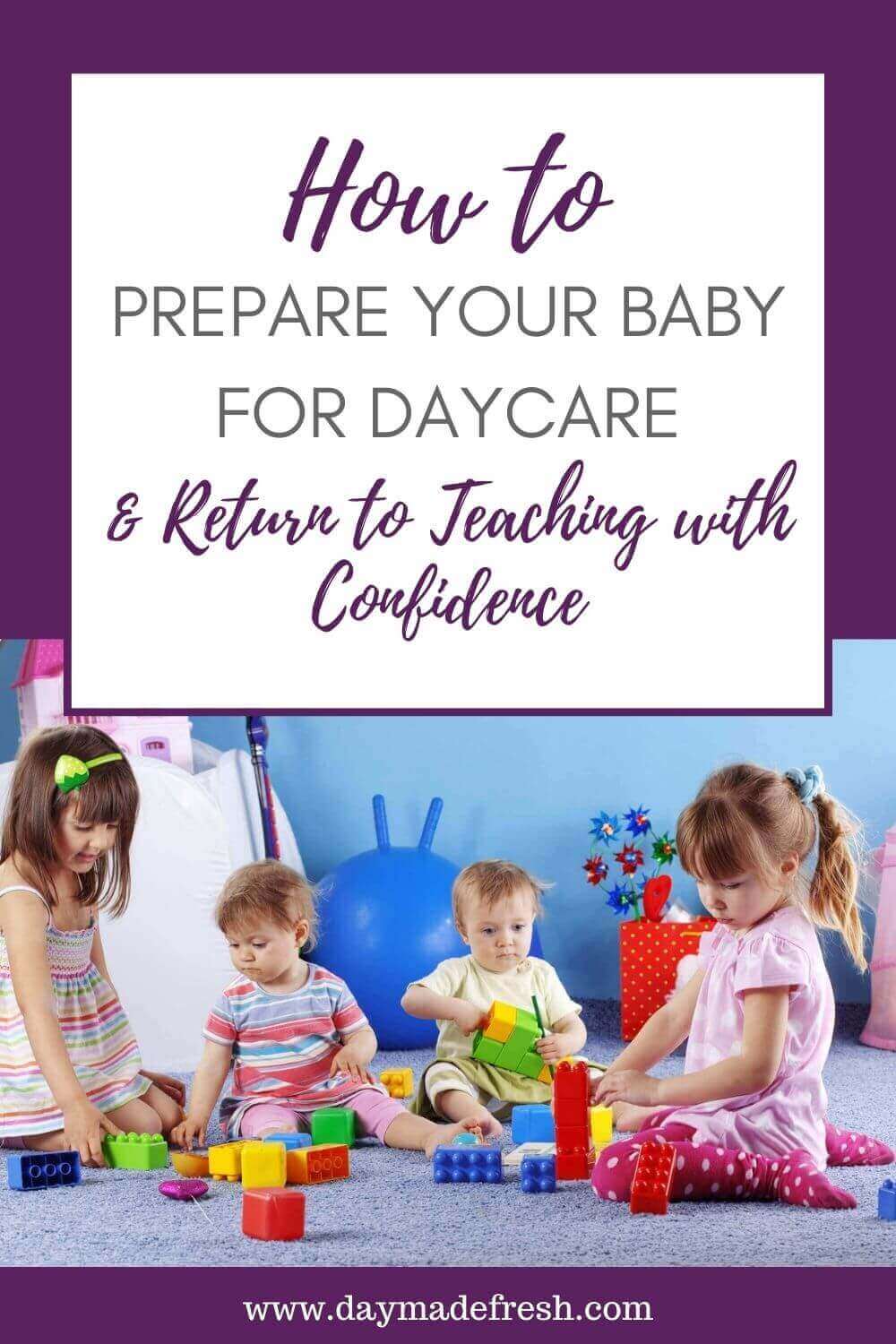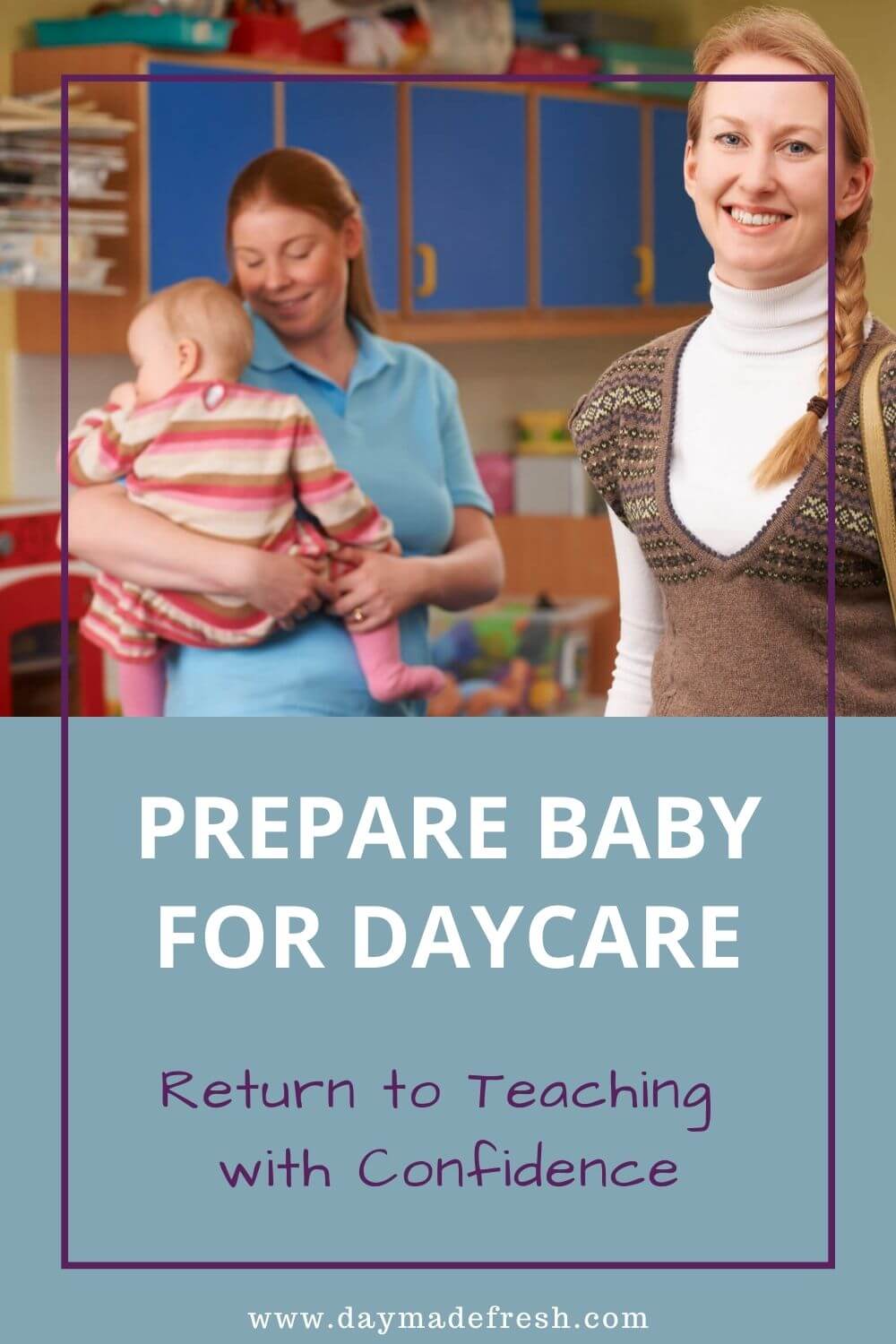Returning to teach after your maternity leave involves you and your baby. One of the many things on your list is to prepare your baby for daycare. Starting daycare is a big transition for the entire family, but it can go smoothly with a little preparation.
Help the transition go smoothly and prepare your baby for daycare
This is an emotional time and whatever emotions you are feeling are valid. You may be excited to return to work and feel “normal.” You may be overwhelmed with sadness at the thought of leaving your baby for the first time. Guilt can also creep in. As teachers, we can feel guilty that we’re having someone else care for our baby while we care for other people’s kids. This is to be expected. You are dealing with the stress of a big change as well as post-partum hormones. My goal is to lower your stress level by helping you feel more prepared for the transition from home to daycare.
Get to Know Your Daycare’s Policies & Practices
The first step in preparing your baby for daycare is to get to know your daycare’s policies and practices. There are many similarities between daycares because of licensing requirements. Yet each daycare is still unique. Make sure you have a clear understanding of your daycare’s policies and practices. This will save you frustration down the road as you start preparing for daycare.
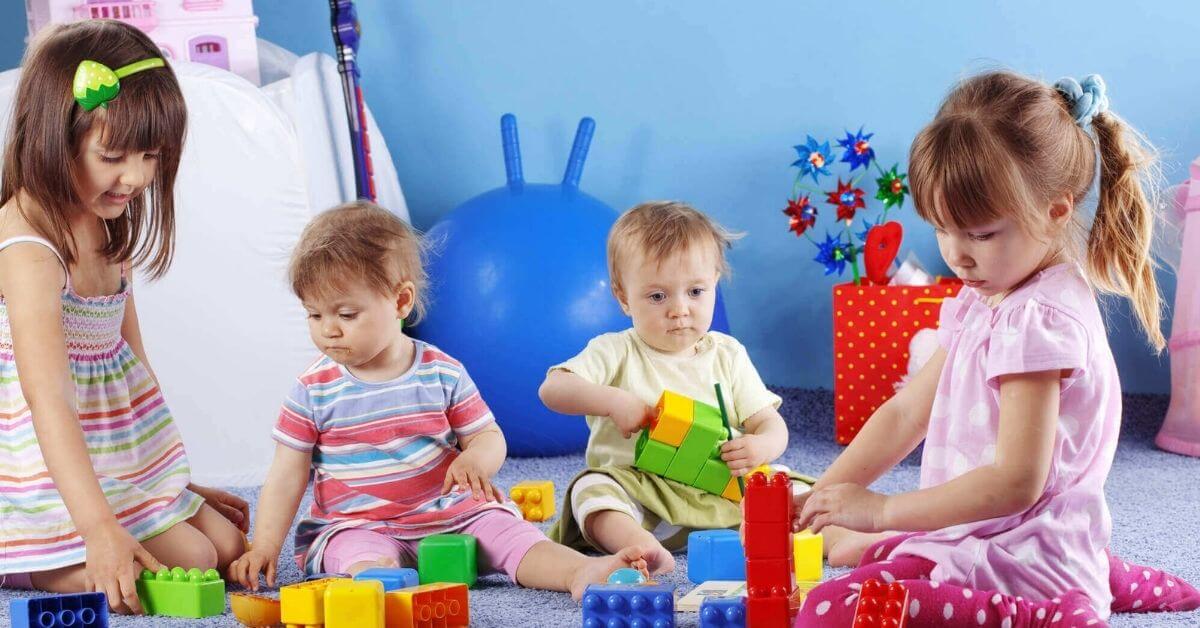
For example, in preparation for our daughter starting daycare I used my label maker to put her name on all her cups, bottles, and dishes. Unfortunately, I did this before we had finalized what daycare she would attend. Our daycare required her first & last name as well as the date on any food or drink items. So this didn’t end up saving us a bunch of time. Oops.
Key Policies & Practices to Take Note OF:
- Fever and Illness- (Especially important with Covid-19) What does your daycare consider a fever? When can your child return to daycare after being ill? How quickly do you have to pick them up once you are called? What about diarrhea/loose stools or vomiting? What is the provider’s mask policy?
- Meal Time- Will you or daycare provide meals? What food will be provided? What can or can’t you send in? How must food and bottles be prepared or packaged? How should bottles or food be labeled? How much breastmilk or formula do they want you to send? Will they feed your baby on-demand or on a schedule?
- Nap Time- Where will baby nap? What can baby have to nap with? Do they do on-demand nap time or scheduled?
- Drop Off/Pick Up- What safety measures are there? Will you have a code to enter the building? Who can or cannot drop the baby off? Do you have to sign in/sign out? (With Covid-19 many providers are adding further safety measures. Such as dropping kids off at the door or only one adult does drop off and pick up).
- Diapers and Wipes- Some daycare providers use the same diapers and wipes on all the kids. This way they don’t have to store each child’s specific diapers and wipes. Other providers have parents provide diapers and wipes. Also, some providers will not use cloth diapers. If you use cloth diapers at home you will need to find a provider who is willing to use cloth diapers or use an alternative while your baby is at daycare.
- Communication- Communication is so important between families and daycare providers. You’ll want to check and see how your provider shares daily information. Will they send a written daily report or will it be a digital report? Do you need to share information with your provider in the morning?
- Miscellaneous- How frequently do kids get to go outside? What is their inclement weather policy? Does your baby need to wear shoes while at daycare? How do they handle potty training?
This post contains some affiliate links for your convenience. Click here to read my full disclosure policy.
Many daycares base their policies on state licensing requirements. They also have things in place to help things run smoothly with multiple kids in one room. This could mean that daycare is very different from what your baby is used to.
Start preparing your baby ahead of time for what it will be like at daycare. This will help things go much more smoothly for all involved.
Looking for checklists to help you save time, so you can spend more time with your family? Click here to download a FREE set of checklists that include:
- An Out the Door Checklist to help you not forget anything on your way to school
- An Evening Must Do Checklist to help you prepare for an easy morning
- A Packing Checklist to make sure you have everything you need for school and your baby needs for daycare.
- AND MORE!
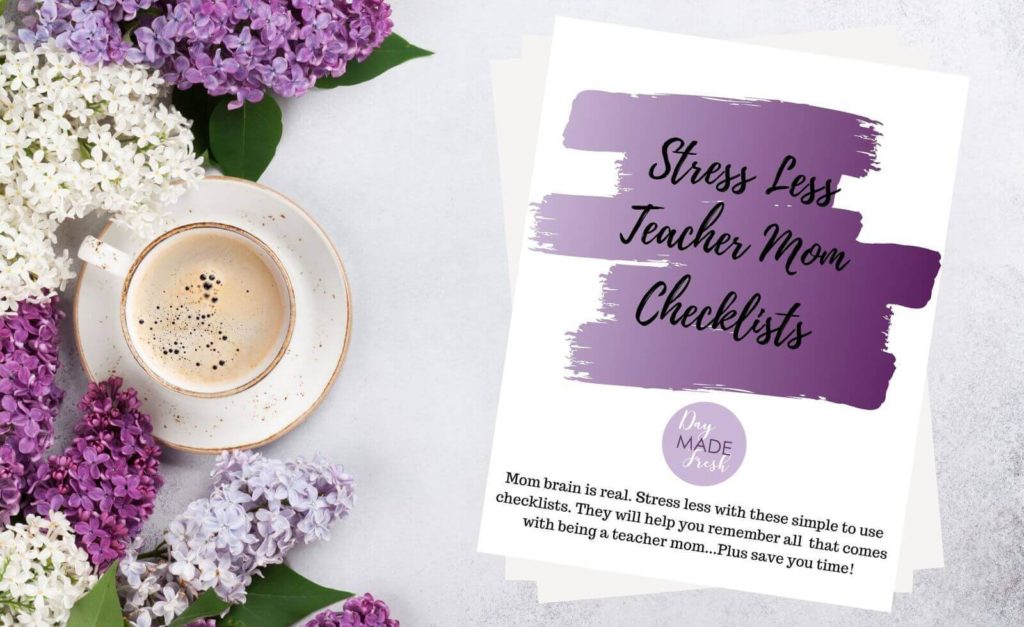
Help Prepare Baby for Naptime at Daycare
One thing that some babies have a hard time with when transitioning to daycare is naptime. At daycare, babies are typically expected to sleep in a crib in a room with other babies trying to sleep in a crib. This is a different sleep environment than they are used to. It will most likely be louder and babies will need to sleep on their own. One goal to have before baby starts daycare is to have them be comfortable sleeping in a crib during the day.
Another goal is that baby can fall asleep on their own. At the very least they should be able to stay asleep on their own once rocked to sleep. Most daycare providers understand that this is an adjustment for your baby. They will work with your baby to make sure he or she gets some sleep.
Most daycares allow infants to sleep on-demand or as needed. They follow your baby’s timeframe. As your child gets older there will most likely be set naptimes. Based on your baby’s age and your daycare’s procedures you may need to prepare your baby for daycare’s nap schedule.
Daycares must also follow safe sleep methods. This means that babies must sleep on their backs without anything else in the crib. If your baby is used to something else you will need to check with your daycare.
Be patient you may have a grumpy baby when they get home for a few days, but he or she will adjust to the new routine.
Prepare Baby for Taking a Bottle at Daycare
Another big transition for some babies is going from being exclusively breastfed to being bottle-fed. Breastfed babies can often take a while to successfully take a bottle. It’s best to start with the bottle months before you plan to return to work teaching. You can usually start practicing with a bottle when babies are a month old. This will allow your baby to grow accustomed to the bottle and for you to build up your supply of frozen milk.
If your baby fights taking a bottle it can add more worry to an already stressful situation. Our daughter fought taking a bottle when we first started trying. She would scream, cry, gag, and end up with more milk on her than in her. My husband and I were so overwhelmed and I was terrified that she would starve when she went to daycare.
We are blessed to have lactation consultants at our local hospital that are always there to help. They had me bring in my daughter so they could demonstrate some techniques to help her drink from the bottle. The advice that the consultant offered was:
1) Keep the session happy, relaxed, and fun. She suggested the minute Cordelia showed she was unhappy to take a break and try again later. She also recommended moving around while trying to feed her. Offering interesting things to look at such as a fan or tv show. We also found listening to music or singing songs helped.
2) Stick to one bottle/nipple type for a while. Don’t keep switching between types. She recommended this so the baby has a chance to get used to the bottle and nipple. If after multiple days or tries it’s not working, then try a new brand or style.
3) Have someone else other than mom give baby the bottle. It may even be best for mom to not be in the same room. This way baby can focus on the bottle.
4) Babies will eventually figure it out and eat. Just like with naps there may be a few days where your baby doesn’t take the bottle that well at daycare. But it will work out. Daycare providers also have a lot of experience giving babies bottles. They will help make it happen. 🙂
I am not a lactation consultant and definitely not an expert. If you need more help with getting your baby to take a bottle check out “Introducing a Bottle to a Breastfed Baby” on La Leche League’s site. I also recommend reaching out to a local lactation consultant or local La Leche League for help. You do not have to do this alone.
To help prepare you for your return to work read my Tips for Breastfeeding and Pumping as a Teacher. If you’re wondering what to wear read Pumping Friendly Work Clothes for Teachers for some great ideas. Still pregnant AND teaching check out some tips to make it a little easier. You can also click below to download your FREE Stress Less Teacher Mom Checklists!
Get Ready for Solid Food at Daycare
Down the road, as your baby gets older they will start needing to take solid food to daycare. Check with your provider and see if they serve their own food or if you are expected to send in food. If you will need to send in the food you’ll want to know what they already have. As well as what you will need to send in each day. Will there be a microwave to warm up food? Will they have plates and utensils? Are there any allergies?
You’ll also want to communicate with your provider how you plan on feeding your baby. Will you be giving your baby purees and baby cereal or do baby-led weaning? If you prefer to do baby-led weaning is your daycare provider comfortable with this technique?
We chose to do baby-led weaning our provider was completely on board and it went very well. We started the baby-led weaning process at home first by starting with dinner. Then we added breakfast at home. This way our daughter was already used to eating solid food. Before we introduced solid food at lunch and as snacks to daycare.
If this is the technique you choose to use, help your provider out. Make sure all the food you send in is already prepared and safe for your baby to eat. My tip is to take time each night to prep all the food for the next day.
We sent two small snacks; fruit, veggie, cheese, cereal, puffs, yogurt melts, etc. For lunch, we typically included a veggie, fruit, and then dairy/protein. As our daughter got older we also included a grain for lunch such as noodles or leftovers from the night before.
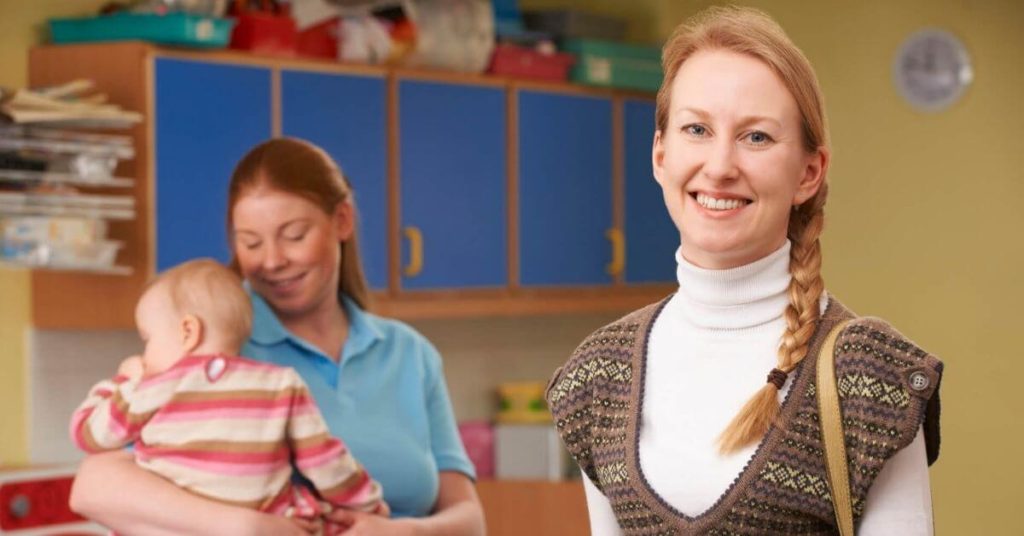
Other Tips to Help Prepare for Daycare
Plan For Having to Leave Work
The first year or longer that a baby is in daycare they will most likely be sick often. If your baby develops a fever or has other symptoms of illness you will have to pick them up. You will want to work out a plan with your partner on how your family will handle this situation when this comes up. Things to think about:
- Who will be first on the contact list for daycare to call?
- Who will pick your baby up? Will, you and your partner take turns picking up and staying home with your baby? Will someone else like a grandma pick him or her up?
- Will you need to switch cars or swap out a car seat for whoever is picking up the baby?
- Will you need to have a go-bag for baby in case they will be staying at someone’s house other than your own?
- Who will stay with your baby the next day? Most daycares will not allow you to return for 24 hours.
If you are going to be the one to pick up and stay home with your child you will also want to plan what will happen at school. You’ll want to have an idea of who will cover your class and what your students will do while you are gone. If you haven’t already done so you will want to create emergency sub plans. Your emergency sub plans should allow whoever is covering your room to use them immediately. They shouldn’t need a lot of background knowledge or advanced preparation.
To decrease the need to scramble it is a good idea to speak with your administrator ahead of time. This way you can create a plan together when things are calm. Having a sick child is already stressful enough. Having a plan ready to go will make the situation less stressful for everyone involved.
Have Daycare-Specific Bags
Originally I planned on sending our diaper bag to daycare each day. In the end, this wasn’t necessary. We kept it separate, so we could keep it packed and ready for our use in the evenings and weekends. Instead, we sent two cloth grocery bags. One stayed at school all week with her daycare blanket, outdoor clothes, change of clothes, sunscreen, etc. The other went back and forth and contained her food bag, milk, and bottles. We liked the grocery bags because they could easily be thrown in the wash to be sanitized every once in a while. Plus if they got lost or damaged it wasn’t a big deal.
Get Two Sets of Winter Clothes
If your family spends a lot of time outdoors, you may want to get two sets of snow gear. This way you can leave one at daycare and have one at home. This will also allow you to have a back-up set if one set gets dirty and needs cleaning. Snow gear can often take a while to get dry, this way you don’t have to wait on it. My tip is to check out your local Goodwill or Once Upon a Child to get your baby’s winter clothes. They grow out of things so quickly and at this age. Plus they don’t always use it on a daily basis.
My FAVORITE THINGS To Help Prepare Baby for DAYCARE:
Washable Reusable Grocery Bags – These are easy to clean and are great for holding all of baby’s gear. If an illness goes through your child’s daycare room you can easily throw these in the wash with the rest of your baby’s things.
Painters Tape– We tried a few different ways to label our daughter’s bottles and other food containers. We found basic blue painters tape worked best. It didn’t leave a sticky residue and it was easy to write on with a sharpie. It also held up if it got damp.
Sistema Food Storage Containers– Once we started sending solid foods we found these two-compartment containers and single compartment containers worked great. They didn’t leak, held up well in the dishwasher, and were a good size portion-wise. (They’ve held up for 2 years of regular use so far). We got enough containers to last us 2-3 days.
Amazon Mama Bear Diapers and Amazon Wipes– We used Amazon Subscribe and Save to keep from having to make diaper runs to the local grocery store and save money. We use Amazon Mama Bear Diapers and Amazon Wipes. They came in smaller packages that we could easily send to daycare.
Neutrogena Pure & Free Baby Mineral Sunscreen– This sunscreen is a mineral versus a chemical sunscreen. It works great for sensitive skin and lasts really well.
Dr. Brown’s Bottles– As I stated earlier it may take a little while to find a bottle that works best for your baby. For our daughter, we used Dr. Brown’s Baby Bottles. An added bonus with these bottles is that you can directly pump into these using a Medela Breast Pump.
Thinkbaby Stainless Steel Thinkster Bottle– Once you start solid foods babies can start having water. We tried so many cups for our daughter and nothing worked. Our pediatrician suggested offering her a water bottle with a straw. She said some breastfed babies do best with a straw. We purchased this water bottle and it worked great! We now have two and use them on a daily basis.
Munchkin Miracle 360 Trainer Cups– These cups are great for once your baby starts to transition away from bottles and/or breastfeeding. They can take some practice, but we found them much better than cups with hard spouts. They’re also easy to wash in the dishwasher. These cups do prevent most spills, but they can leak. When our daughter started to drink whole milk we sent one of these cups and sent her milk in a Dr. Brown’s bottle.
Sun Hat– If your child is going to be outside frequently at daycare an item you will want to pack is a sun hat. This way you know their delicate skin is protected on their face. We love this SwimZip Kid’s Sun Hat it is adjustable so it stays on great plus it is meant to get wet. Our daughter and now our son gets a lot of use out of it.
Helping prepare your baby for daycare will help you return to teaching with confidence. With a little preplanning, you can help ease your baby’s transition and make the process less stressful. Babies pick up on how their parents are feeling, so if you are calm, relaxed, and positive your baby is more likely to be as well.
Related Post: Overcome Mom Brain Forgetfulness
That doesn’t mean this isn’t going to be quite the adjustment for you and your baby. It is ok if you are mourning the end of your maternity leave; it’s also ok if you’re jumping for joy that it is over. Some days it will be hard to leave your baby while you go to school. Remember that at the end of the day you get to experience the joy of your child seeing you when you come to pick them up.
Just as you care for and love the students in your classroom your daycare provider will love and care for your sweet baby. Eventually attending daycare will become the norm. Don’t forget to bring a little more calm into your life with these Stress Less Teacher Mom Checklists!
